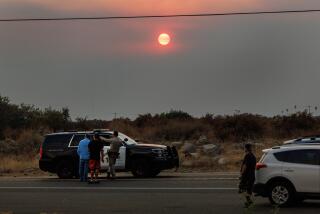Audit of Smog District Urges Improvements
The South Coast Air Quality Management District must simplify its confusing rules and regulations, improve lines of communication among its divisions and pay more attention to major industrial sources of pollution to reduce smog levels in Southern California, according to an audit of the district released Thursday.
But overall, the agency charged with monitoring and reducing pollution in a four-county area has made “significant improvements” since it was last investigated in 1981, said the audit conducted over an eight-month period by the U.S. Environmental Protection Agency and the state Air Resources Board with the cooperation of the AQMD.
From the very beginning of the audit the AQMD has closely cooperated with the state and federal investigators. Indeed, the evaluation had been termed by all three agencies as a cooperative endeavor. As late as last Monday, Ed Camarena, director of enforcement at AQMD, flew to Sacramento to present the district’s final suggested revisions for the report released Thursday.
“For the most part, the criticisms were fair,” said Norton Younglove, Riverside County supervisor and chairman of the board of the AQMD, which monitors air pollution in Los Angeles, Orange, Riverside and San Bernardino counties. “The district doesn’t walk on water. I take this as constructive criticism.”
Some other people, however, called the much-awaited report’s findings “milquetoast” and its recommendations “obvious.”
“It’s stuff we’ve been talking about for a long time,” added Larry Berg, director of the Institute of Politics at USC and a member of the AQMD Board of Directors. “What’s new about it?” He compared the relationship between the state and federal investigative agencies and the AQMD to “one fox looking at another fox that’s guarding the chickens.”
“It is obvious that the EPA and the ARB discipline the district as well as the district disciplines polluters--which isn’t saying much,” said Kelly Hayes-Raitt, spokeswoman for the Santa Monica-based Coalition for Clean Air. “The report, for example, focuses on intra-divisional communications and not the way the district communicates with the general public.”
“They are trying to take the flies-to-honey approach in which they are not so publicly critical of the district but still state their objections to district practices,” said Sabrina Schiller, an AQMD board member. “The district will get the point and implement the suggestions without being beaten to do so.”
The audit, touted as the most comprehensive ever on an air pollution control agency, inspected more than 230 industrial facilities and 420 gasoline stations with a goal of finding the “big payoff areas” of potential improvement, said Jim Boyd, ARB executive officer. Similar reviews of local air quality programs in the San Francisco Bay Area and San Diego are planned in 1987.
“Some people may be disappointed that we can’t find more emissions reductions just through better enforcement of existing rules and regulation,” Boyd said. “But the good old days of great big bites out of emissions are gone. The simple things have all been done.”
Nonetheless, the audit did admonish the district in several areas.
While the audit lauded the AQMD’s service station vapor-recovery program--the non-compliance rate is the lowest in the nation at 6.9%--it also said that the district should take a more aggressive approach with major industrial polluters. Environmentalists have long voiced that view.
The audit also said the district is not doing enough to discourage companies from non-compliance with a requirement to obtain a permit to construct.
“SCAQMD management indicated that 60% of the approximately 10,000 permit applications processed each year” were for sources that did not obtain permits before construction. Rather than prosecuting these violators, the district usually levied a fine of $400, the audit said.
The audit also said that district’s rules are fraught with “ambiguous, conflicting and unenforceable language” that often “lead to enforcement problems” and differing interpretations among sometimes inadequately trained inspectors and supervisors.
A formal process for resolving rule interpretation does not exist, the audit said. Instead, “an informal process among enforcement and engineering staff is used. This process is time-consuming, inefficient and in several cases resulted in decisions inconsistent with either the rule or previous decisions.”
“I would of come up with the same problems,” acknowledged Jim Lents, AQMD’s executive officer. “Generally, the district is doing a good job.”
Meanwhile, state Sen. Robert Presley (D-Riverside) has introduced legislation to revamp the pollution agency’s board.
More to Read
Sign up for Essential California
The most important California stories and recommendations in your inbox every morning.
You may occasionally receive promotional content from the Los Angeles Times.










